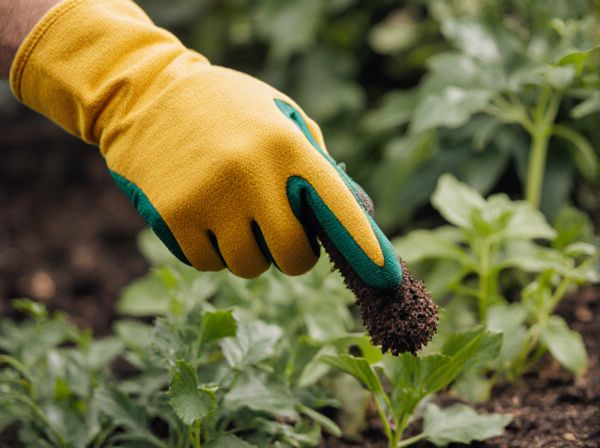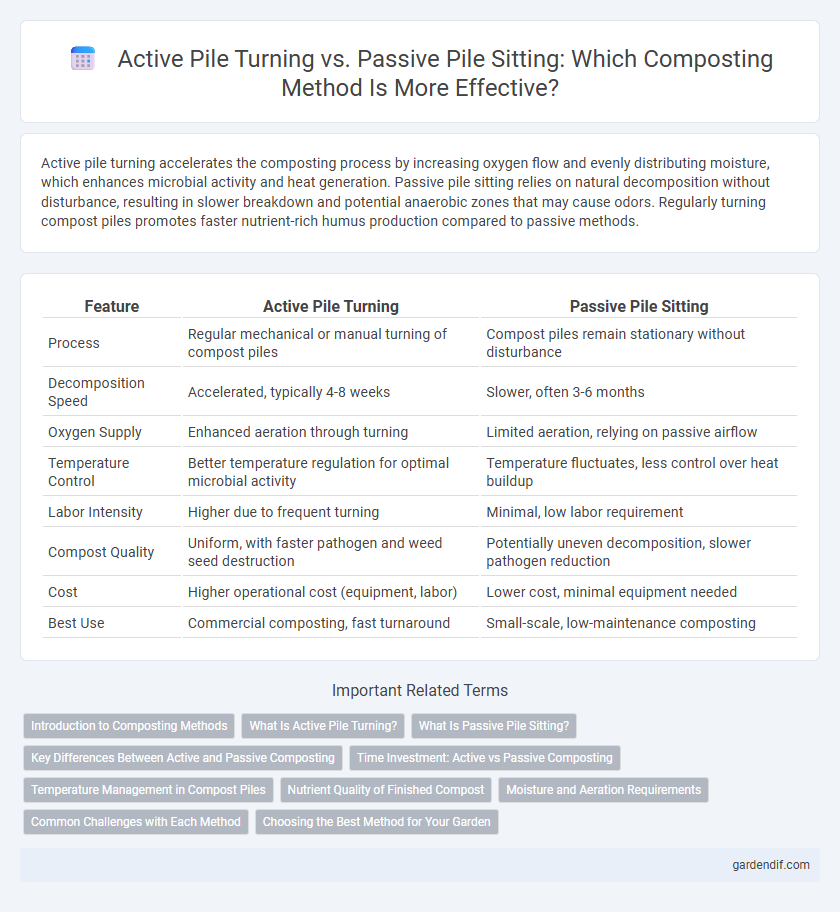
Active Pile Turning vs Passive Pile Sitting Illustration
Active pile turning accelerates the composting process by increasing oxygen flow and evenly distributing moisture, which enhances microbial activity and heat generation. Passive pile sitting relies on natural decomposition without disturbance, resulting in slower breakdown and potential anaerobic zones that may cause odors. Regularly turning compost piles promotes faster nutrient-rich humus production compared to passive methods.
Table of Comparison
| Feature | Active Pile Turning | Passive Pile Sitting |
|---|---|---|
| Process | Regular mechanical or manual turning of compost piles | Compost piles remain stationary without disturbance |
| Decomposition Speed | Accelerated, typically 4-8 weeks | Slower, often 3-6 months |
| Oxygen Supply | Enhanced aeration through turning | Limited aeration, relying on passive airflow |
| Temperature Control | Better temperature regulation for optimal microbial activity | Temperature fluctuates, less control over heat buildup |
| Labor Intensity | Higher due to frequent turning | Minimal, low labor requirement |
| Compost Quality | Uniform, with faster pathogen and weed seed destruction | Potentially uneven decomposition, slower pathogen reduction |
| Cost | Higher operational cost (equipment, labor) | Lower cost, minimal equipment needed |
| Best Use | Commercial composting, fast turnaround | Small-scale, low-maintenance composting |
Introduction to Composting Methods
Active pile turning accelerates composting by increasing aeration and distributing moisture, promoting faster decomposition through enhanced microbial activity. Passive pile sitting relies on natural processes without disturbance, resulting in slower breakdown due to limited oxygen flow and uneven moisture levels. Choosing the appropriate method depends on desired composting speed, space availability, and management preferences.
What Is Active Pile Turning?
Active pile turning is a composting technique that involves regularly aerating organic waste by physically turning the compost pile to enhance microbial activity and accelerate decomposition. This method maintains optimal oxygen levels, temperature, and moisture, resulting in faster nutrient-rich humus production compared to passive pile sitting. Frequent turning prevents anaerobic conditions, reduces odor, and promotes efficient breakdown of organic materials.
What Is Passive Pile Sitting?
Passive pile sitting is a composting method where organic materials decompose naturally without frequent disturbance or aeration. This technique relies on microbial activity within a stationary pile, leading to slower decomposition compared to active pile turning. It is energy-efficient but may result in uneven breakdown and longer composting periods.
Key Differences Between Active and Passive Composting
Active pile turning accelerates composting by increasing oxygen flow, promoting aerobic microbial activity, and maintaining optimal temperature levels, resulting in faster organic matter breakdown. Passive pile sitting relies on natural microbial processes with minimal disturbance, leading to slower decomposition and potential anaerobic zones due to limited aeration. Key differences include the rate of compost maturation, oxygen availability, and microbial efficiency, with active turning favoring quicker nutrient-rich compost production.
Time Investment: Active vs Passive Composting
Active pile turning accelerates the composting process by frequently aerating organic materials, reducing decomposition time to weeks instead of months. Passive pile sitting requires minimal labor but extends the composting duration due to limited oxygen flow and slower microbial activity. Time investment in active composting yields faster nutrient-rich compost compared to the passive method's lower maintenance but prolonged timeline.
Temperature Management in Compost Piles
Active pile turning in composting significantly enhances temperature management by increasing oxygen flow and distributing heat evenly, which accelerates microbial activity and organic matter decomposition. Passive pile sitting relies on natural aeration and microbial heat generation, often leading to uneven temperature gradients and slower composting rates. Consistent temperature control through active turning reduces the risk of anaerobic zones and pathogen survival, ensuring a more efficient and hygienic composting process.
Nutrient Quality of Finished Compost
Active pile turning significantly enhances the nutrient quality of finished compost by promoting aerobic decomposition, which increases microbial activity and accelerates organic matter breakdown. In contrast, passive pile sitting tends to result in slower decomposition and lower nutrient availability due to limited oxygen penetration and uneven microbial distribution. Consequently, regularly turned compost piles produce richer, more balanced nutrients essential for soil health and plant growth.
Moisture and Aeration Requirements
Active pile turning enhances aeration by regularly introducing oxygen, which accelerates microbial activity and controls moisture levels, preventing anaerobic conditions and excessive dampness. Passive pile sitting relies on natural diffusion for aeration, often resulting in uneven oxygen distribution and potential moisture buildup, slowing down the composting process. Maintaining optimal moisture (40-60%) is easier with active turning, ensuring efficient decomposition and minimizing odor issues.
Common Challenges with Each Method
Active pile turning accelerates aerobic decomposition but often faces challenges such as uneven moisture distribution and increased labor costs. Passive pile sitting requires minimal intervention but struggles with slower decomposition rates and potential anaerobic conditions leading to foul odors. Both methods demand careful moisture and temperature management to optimize microbial activity and prevent nutrient loss.
Choosing the Best Method for Your Garden
Active pile turning accelerates composting by aerating the organic material, promoting microbial activity and faster decomposition, ideal for gardeners seeking quick nutrient-rich compost. Passive pile sitting requires minimal effort, relying on natural processes but takes significantly longer, suitable for low-maintenance gardening. Selecting between active turning and passive sitting depends on your time availability, garden size, and desired composting speed to optimize soil enrichment.
Active Pile Turning vs Passive Pile Sitting Infographic

 gardendif.com
gardendif.com